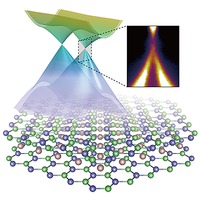Abstract
We report the discovery of a new three-dimensional (3D) topological Dirac semimetal (TDS) material KZnBi, coexisting with a naturally formed superconducting state on the surface under ambient pressure. Using photoemission spectroscopy together with first-principles calculations, a 3D Dirac state with linear band dispersion is identified. The characteristic features of massless Dirac fermions are also confirmed by magnetotransport measurements, exhibiting an extremely small cyclotron mass of and a high Fermi velocity of . Interestingly, superconductivity occurs below 0.85 K on the (001) surface, while the bulk remains nonsuperconducting. The captured linear temperature dependence of the upper critical field suggests the possible non--wave character of this surface superconductivity. Our discovery serves a distinctive platform to study the interplay between 3D TDS and the superconductivity.
- Received 25 August 2020
- Revised 13 March 2021
- Accepted 7 May 2021
DOI:https://doi.org/10.1103/PhysRevX.11.021065
Published by the American Physical Society under the terms of the Creative Commons Attribution 4.0 International license. Further distribution of this work must maintain attribution to the author(s) and the published article’s title, journal citation, and DOI.
Published by the American Physical Society
Physics Subject Headings (PhySH)
Popular Summary
The superconducting state in topological matter—systems with properties impervious to defects or perturbations—has attracted tremendous interest because of the possibility of realizing Majorana fermions, quasiparticles that are a desired component of quantum computation. Among the various topological systems, one compelling candidate for superconductivity is the 3D topological Dirac semimetal (3D TDS), an exotic material with novel electronic properties such as high electron mobility. However, superconductivity in 3D TDS has been induced only under certain conditions such as high pressure. In this work, we discover a new 3D TDS, KZnBi, which is constructed with a planar honeycomb lattice, exhibiting a naturally formed surface superconductivity under ambient pressure and inert conditions.
By using angle-resolved photoemission spectroscopy together with first-principles calculations, we demonstrate that signatures of a 3D TDS originate from the planar ZnBi honeycomb layer. Magnetotransport properties, meanwhile, reveal a characteristic feature of Dirac fermions, further supporting that the system is a 3D TDS. More interestingly, we verify that the superconductivity of the 3D TDS KZnBi occurs at the surface of the crystal, while the bulk remains in a nonsuperconducting topological Dirac state.
Our discovery provides a new 3D TDS that exhibits a surface superconducting state. We believe that if this surface superconducting state correlates with the topological nature of the bulk Dirac states, it would be interesting for the research and future applications of topological superconductivity.



